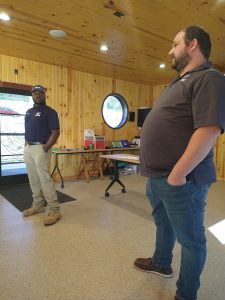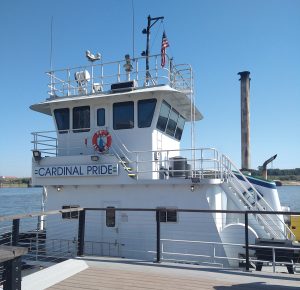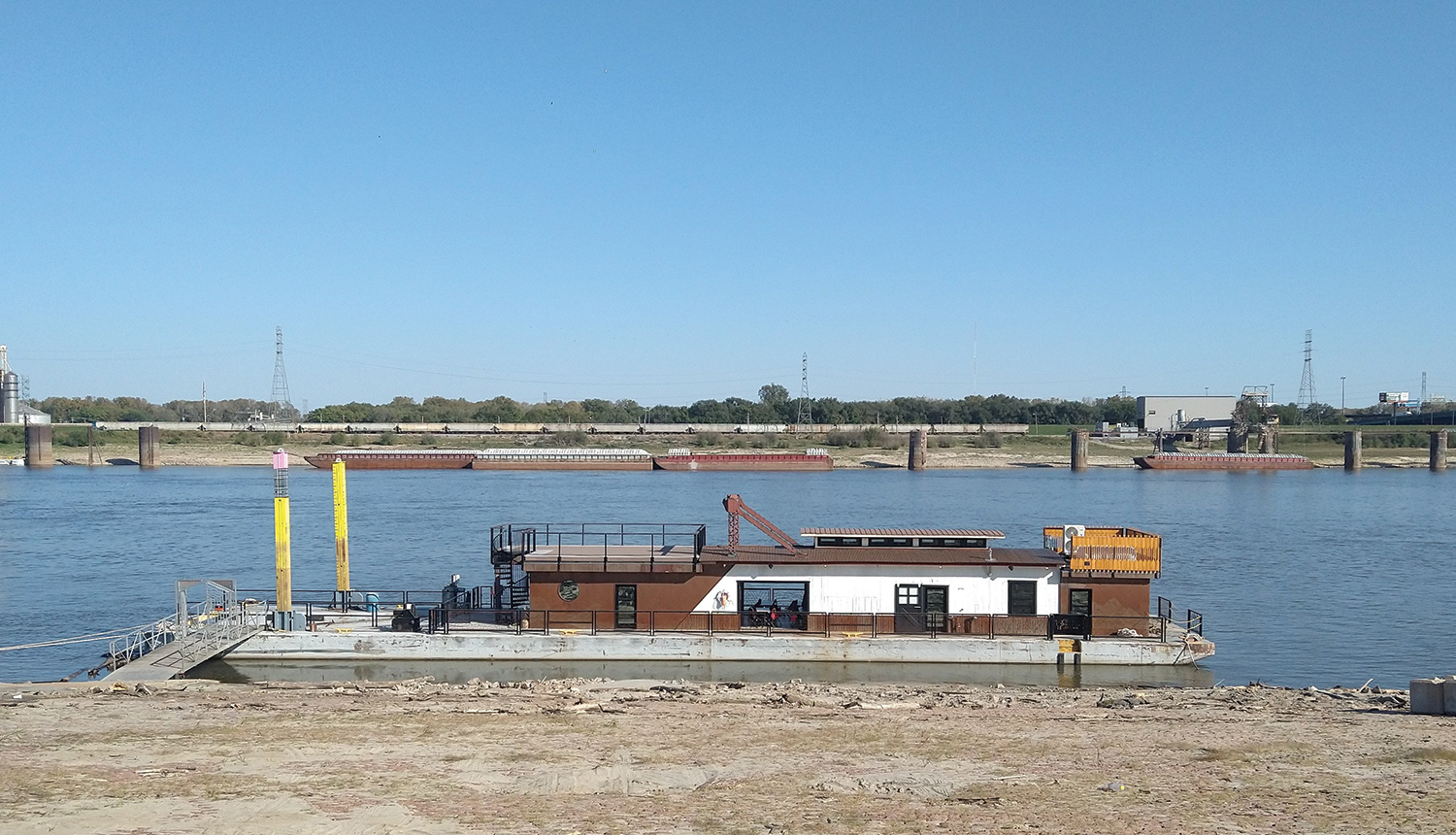The Mississippi River Institute barge stands out against other river vessels with its yellow pencil and ruler spuds. This barge was constructed by Living Lands & Waters (LL&W), and it’s on the river specifically to educate young people about career opportunities on the Mississippi River.
Classroom education at Living Lands & Waters began in 2002. With the help of Marquette Transportation, LL&W’s first educational barge was refitted into a floating headquarters with dormitories and a classroom space. This classroom was specifically designed for teachers, and so far 1,400 teachers have attended workshops to learn about conservation efforts and the importance of clean water. A bigger, second classroom was built in 2012, this time for students. This barge is still in operation and focuses on environmental education and environmental science workshops. Students engage in lab activities, such as water quality testing and macroinvertebrate identification, and even spend time cleaning up the river toward the end of the day.

The Mississippi River Institute, the third classroom barge to join the fleet, is in the midst of its very first semester in operation. LL&W has dedicated this barge to marine career development for high schoolers. The barge can accommodate up to 30 students and operates as a classroom nine months out of the year, alternating between St. Paul, Minn., Memphis, Tenn., and St. Louis.
Over the past 22 years, more than 2,800 students have received an education on a Living Lands & Waters classroom barge so far.
“I wanted to build an inspirational program, not something that kids just walk through,” said Chad Pregracke, the founder of Living Lands & Waters. “I wanted something that is geared toward them and where they are at in life and show them in a really positive light all the great careers you can have on the river, whether you go to college or not. On the other barge, we frame the Mississippi as a 2,300-mile corridor for wildlife. On this one, we are framing the Mississippi—and we hope they will too—as a 2,300-mile corridor for opportunity.”
The day starts with an introduction from Rachel Loomis, manager of the Mississippi River Institute, and a video about Pregracke and the Living Lands & Waters story, crew and mission. Students are given LL&W pencils to write down their values, their natural gifts, what they want to work toward, who they want to influence, and their interests. Students then hear from one or two guest speakers chosen by their teachers with Loomis’s help. This is followed by lunch and a career video highlighting more than 25 different job avenues the river provides, and then one final guest speaker. The day concludes with a tour of the classroom barge and a towboat where students can meet the crew and captain, as well as see the galley, engine room and wheelhouse.
Kids leave in the afternoon with recruitment information from the guest speakers and are encouraged to scan a QR code in which they enter their email and the river careers that most interest them. Living Lands & Waters then reaches out to these students with hiring and career opportunities related to those fields, as well as LL&W volunteer information.
“We’re trying to give these students a day to think about the river and to think about their future,” Pregracke said. “My hope, and Rachel’s, is that what we’re doing will help shape lives. I think people will be inspired. If they’re not exposed to it, they will never be involved with it.”
While students hear from a handful of guest speakers, Loomis emphasizes the diverse array of job opportunities the Mighty Mississippi has to offer. Careers such as engineering, biology, deckhands, hospitality, cooking, human resources, journalism and marketing are just a few that students are made aware of.
“We’re not telling them who to be,” Loomis said. “We’re exposing them to all the different avenues that they can take in life. If they want to be a businessperson, if they want to be a deckhand, if they want to be a water quality specialist, there’s a place with the river for them. It’s exciting because there are so many people who know about the river and cross these bridges but don’t know what really takes place out here. These jobs that we’re highlighting really celebrate the river and get folks connected to it in various ways. The river is out here to educate people for not only this generation but generations to come. These rivers, America’s back roads, really keep our country up and running, and there are a lot of careers out here because of them.”
Living Lands & Waters is committed to making the workshops as accessible as possible. Schools need only fill out the form on the Mississippi River Institute website with an email, school name and class grade to reserve a spot. Because of the generosity of LL&W sponsors, classes can not only attend workshops for free but are also able to receive a $400 scholarship to cover busing and substitute teacher fees.

“It doesn’t matter what kind of class you have,” Loomis said. “It can be your science class, your welding class, your art class. All those topics can relate to the river.”
The Mississippi River Institute is a testament to the mission and inspiration behind Living Lands & Waters, which has been dedicated to river cleanup and environmental conservation since its founding in 1998. The decorative signs plastered on the interior walls of the barge were all pulled from the river, as was the wood for a corner counter and the colorful planks in the ceiling. The sides of the barge are old tractor sheets, and the rebar used for the railing was also recycled.
The structure itself was a 1930s crane barge that was used to lift wickets from the Ohio River.
Loomis emphasized that hardly anything on the barge was made specifically for the Institute. Instead, components were reused, refurbished and recycled. The Institute is currently looking for pennant flags from marine-related businesses to display on the classroom ceiling to inspire students.
“There’s a lot of value to having us go to their classrooms,” Loomis said, “but it’s also a really one-of-a-kind experience to be able to say you’re sitting right on the Mississippi River.”
Loomis first got involved with Living Lands & Waters as an attendee of LL&W’s annual Alternative Spring Break, where college students from around the country join LL&W crew in Memphis to clean up garbage.
So far, Living Lands & Waters has removed more than 13.5 million pounds of garbage from the rivers of the United States and planted more than 2 million trees. Pregracke said the organization and its volunteers have recovered nearly half a million pounds of waste so far in 2024 and just recently removed 52 cars and other debris—amounting to more than 120,000 pounds—from Pittsburgh rivers with the help of divers and companies like Campbell Transportation Company and ACBL.
The Mississippi River Institute will remain in St. Louis until mid-November, then move down to Memphis. The Living Lands & Waters crew is currently in Cincinnati, working on the Ohio River with an excavator in locations with large amounts of garbage.
————
Feature photo caption: The Mississippi River Institute barge will remain docked in St. Louis before heading downriver to Memphis, Tenn., in November. (Photos by Amelia Kingman)




